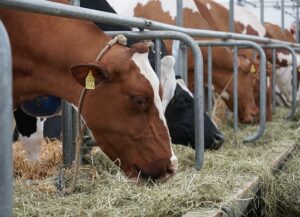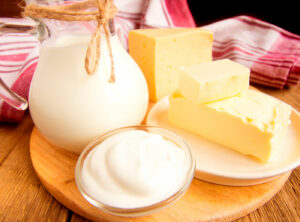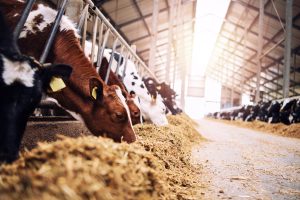Ishaya U. Gadzama & Fernando Diaz
Dairy cows require glucose during lactation for milk synthesis and maintenance of body tissues. Ruminal degradation of soluble sugars and starches into volatile fatty acids limits the amount of glucose that can be absorbed in the small intestine. This may limit milk synthesis and reproductive performance during the lactation.
Post-ruminal supply of glucose has been proposed as a dietary strategy to improve cow’s productive performance and health status. A study conducted at the Experimental Dairy Farm of the Hunan Institute of Animal and Veterinary Science, Changsha, China investigated the effects of feeding rumen-protected glucose (RPG) on the performance of transition cows.
The researchers (Li et al., 2019) fed Holstein cows pre- and post-partum diets supplemented with either 200 g per cow per day of RPG or 90 g/d of coating fat. The RPG product contained 45.0% glucose and 45% of coating fat, and 10.0% moisture. The diets were fed from one week before to two weeks after calving.
Dry matter intake was not affected by RPG supplementation during the transition period (average: 8.1 kg/d). Similarly, there was no difference in milk fat (4.30%) and protein contents (4.39%) between treatment groups. However, cows that received RPG produced more milk (18.9 kg/d) than cows that did not receive glucose (16.9 kg/d).
Although prepartum energy balance (–10.6 Mcal/d) was not affected by dietary RPG supplementation, cows supplemented with glucose showed lower energy balance (–5.4 Mcal/d) during the postpartum period than unsupplemented cows (–3.2 Mcal/d). In addition, total tract digestibility of organic matter, protein, fat, and fiber were unaffected by RPG supplementation in both prepartum and postpartum periods.
Feeding RPG lowered plasma glucose concentration (4.16 vs. 5.51 mmol/L) as compared with the control group. Moreover, cows fed RPG had higher plasma concentration of insulin (2.42 vs. 1.58 ng/ml) and non-esterified fatty acid (NEFE; 0.85 vs. 0.62 mmol/L). These NEFA values agreed with the decreased energy balance postpartum observed in cows receiving glucose.
Interestingly, there was no treatment difference in plasma concentrations of β-hydroxybutyric acid (0.77 mmol/L), triglyceride (0.48 mmol/L), cholesterol (1.95 mmol/L), high- (1.15 mmol/L) and low-density lipoprotein cholesterol (0.65 mmol/L).
In conclusion, the results of this study indicate that supplementation with RPG improves milk production without affecting feed intake and milk composition. However, RPG supplementation exacerbated the negative energy balance in fresh cows. This suggests that the supplement amount of RPG at 200 g/d may not be enough for covering cow’s energy requirements, so they mobilize more body fat. Further research is needed to evaluate greater inclusion levels of RPG.
Reference
Li, X.P., Tan, Z.L., Jiao, J.Z., Long, D.L., Zhou, C.S., Yi, K.L., Liu, C.H., Kang, J.H., Wang, M. Duan, F.H., Tang, S.X., He, Z.X., and Han, X.F. 2019. Supplementation with fat-coated rumen-protected glucose during the transition period enhances milk production and influences blood biochemical parameters of liver function and inflammation in dairy cows. Animal Feed Science and Technology. 252: 92 – 102.
© 2019 Dairy Knowledge Center, LLC. All Rights Reserved.








